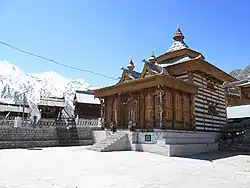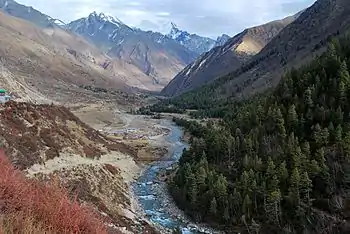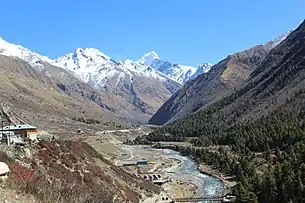Chitkul
Chitkul (or Chittkul) is a village in Kinnaur district of Himachal Pradesh. During winters, the place mostly remains covered with the snow and the inhabitants move to lower regions of Himachal.
Chitkul | |
|---|---|
village | |
 Mathi temple at Chitkul, the locals say it could be 500 years old. | |
 Chitkul Location in Himachal Pradesh, India  Chitkul Chitkul (India) | |
| Coordinates: 31.3518411°N 78.4368253°E | |
| Country | |
| State | Himachal Pradesh |
| District | Kinnaur |
| Elevation | 3,450 m (11,320 ft) |
| Population (2010) | |
| • Total | 882 |
| Languages | |
| • Official | Hindi |
| Time zone | UTC+5:30 (IST) |
| PIN | 172106 |
| Vehicle registration | HP- |
| Nearest city | Rampur |
| Climate | very cold (Köppen) |
According to a recent study by Centre of Atmospheric Sciences at IIT Delhi, Chitkul has the cleanest air in India.[1][2]
Geography
Chitkul, on the banks of Baspa River, is the first village of the Baspa Valley and the last village on the old Hindustan-Tibet trade route. It is also the last point in India one can travel to without a permit.[3]
Visitor's attractions
Of particular interest at Chitkul are its houses with either slate or wooden plank roofs, a Buddhist temple and a small tower. However, there has been an increased use of tin-roofs, especially the high school and the army/ITBP barracks.
The Kagyupa temple has a highly valued old image of the Shakyamuni Buddha, a Wheel of Life mandala and four Directional Kings on either side of the door. Chitkul is practically the last point of the famous Kinner Kailash Parikrama as one can hitch a hike from here onwards.
After one crosses over the 5,242 m high Charang Pass.,[4] it is a long and steep run down through slithery scree slopes to Chitkul(3,450m). The powerful goddess of Chitkul is the only non-Buddhist deity to which respect must be paid by the Parikrama pilgrims. It is believed that the local Deity is related to the Deity of Gangotri and till recently the locals would carry the Deity to Gangotri on foot over high mountain passes.[5] Chitkul is situated around 40 km from Karcham, the place where road bifurcates from Hindustan-Tibet Road (NH 22). The Sangla Valley is a delight for nature lovers; especially the stretch after Raksham and right up to Chitkul. The valley is extremely beautiful, on the left bank of the Baspa River are snow-clad mountains and on the right bank the whole terrain is full of apple orchards and wooden houses.
Chitkul is start point for Lamkhaga pass trek and Borasu pass trek. Nagasthi ITBP post is 4 km and Ranikanda meadows is 10 km trek from Chitkul.[6]
Transport
Chitkul is around 569 km from the National capital Delhi and 28 km from Sangla.[7]
Gallery
 Baspa River flowing next to Chitkul
Baspa River flowing next to Chitkul Wooden hut in Chitkul
Wooden hut in Chitkul Chitkul during Dusk
Chitkul during Dusk Chitkul
Chitkul Inhabitant of Chitkul in traditional clothes of the region
Inhabitant of Chitkul in traditional clothes of the region Domesticated goat
Domesticated goat Snowing in Chitkul
Snowing in Chitkul River Baspa at Chitkul
River Baspa at Chitkul Chitkul border of India.
Chitkul border of India. The last Dhaba
The last Dhaba
See also
References
Chitkul Tourist Places Information In Hindi
- "Among metros, Delhi worst hit by PM2.5: Study". www.timesofindia.indiatimes.com. Retrieved 17 April 2016.
- "Kinnaur District In Himachal Pradesh Has The Cleanest Air In India, According To IIT!". indiatvnews.com. Retrieved 17 November 2017.
- "Chitkul, Kinnaur, Himachal Pradesh, India Tourist Information". Retrieved 20 January 2013.
- "Kinnaur Kailash Parikrama trek - Charang La". Raacho Trekkers.
- "Chitkul the last Indian Village". Retrieved 20 January 2013.
- "Chitkul to Dumti via Ranikanda meadows". Raacho Trekkers.
External links
| Wikivoyage has a travel guide for Chhitkul. |
| Wikimedia Commons has media related to Chitkul. |